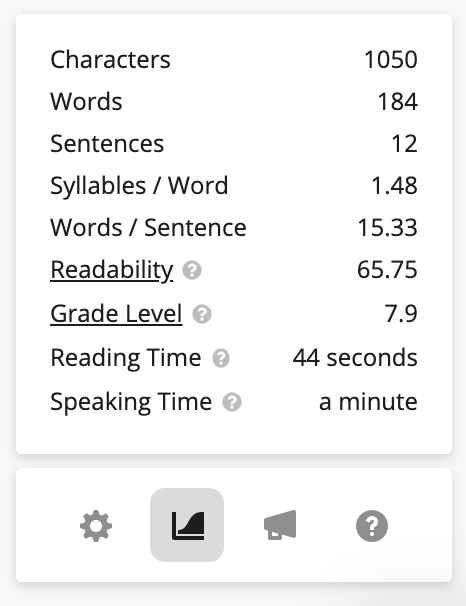Why you should make your writing more readable (and how to do it)
Find out what readability is, why it's important, and how to increase your score.

If you’re writing copy for an organization, you should always be thinking about something called readability. Defining and measuring readability is somewhat complex, but for our purposes let’s think of it as how easy it is to understand a piece of writing.
Enhancing readability is important for multiple reasons. For one, it makes your writing more accessible. Assuming the reading ability of your audience is risky, so by making your work as simple as possible, you’re lowering the possibility of a potential customer clicking away because they don’t understand what they’re reading. But improving readability also has the potential to broaden your audience; in an age of dense government business regulations, learning how to simplify second-hand information for your would-be clients is a critical skill. We’ve also got to remember what platform most of us are writing on; the internet. The truth is, most people won’t read everything you’ve written no matter how entertaining. The simpler your copy is, the easier it becomes for people to jump in and out of the text while still understanding it.
“Well, then,” I can hear you say, “that’s easy. I’ll just make my writing simpler.” That’s a good start. But how well a person can understand your writing is not just down to how simple it is to read. It’s also influenced by how interesting it is. A piece of writing might be completely straightforward, but if it’s got nothing to say then it won’t say anything to the person reading it.
So, in the blog below, you’ll find Outwrite’s tips to readability success. I’ve divided them into two categories; the Concrete—how to write so your copy is simple and easy to understand—and the Creative—tricks to make your writing just that bit more intriguing.

The Concrete
Use simple words
The best way to make your writing simpler is to use simple words. Remember, your copy shouldn’t make you look smart, it should make your reader feel smart. When you’re proofreading, think about the clientele who will be reading it and consider whether all of them will understand it. For one thing, that means staying away from jargon. If you absolutely must include it, make sure you define it for the audience. If you're writing for a global corporation, your writing might be read by people who are new to English, so stay away from local colloquialisms. Your copy shouldn’t be a comprehension test.
Shorten your sentences
I’ve told you before, and here I am telling you again; don’t try to string together long sentences with commas. When you do this, there’s a high chance you’ll make a grammatical error (gasp!). But, even if you don’t, you’ll likely create a sentence that your readers have to skim over again due to the sheer volume of words. When your sentences are short and only contain one key idea, they’re punchy and easy for your audience to comprehend.
Think about order
Sometimes, you’ll have to write about things that are difficult to explain or that your audience might not have come across before. When this is the case, be sure to order your writing carefully. Always mention something your audience understands before bringing up something they don't. The easiest way to do this is by using connecting words like, “this”, “such as”, and “therefore”.
Creative
Write creatively
When I say “write creatively”, I don’t mean spend hours thinking about beautiful turns of phrase to create some sort of blog-literary masterpiece. I mean use the creative writing practice of “showing and not telling.” You can make your writing so much more engaging by using nouns and verbs and leaving the adjectives out whenever you can. Sure, sometimes you’ll need them to describe just how fantastic a product is. But if you’re explaining how something works, “showing” its function in your writing is the way to go.
Entertain your readers
This tip is certainly the most difficult to implement. In fact, it’s not so much a tip as a reminder. Making your writing entertaining will make it all the more readable, because readability is not just defined by the difficulty of the text, but by how much the reader wants to read it. If your copy is 2000 words of bleak prose, no one’s going to make it to the end. So try to make your writing entertaining. It doesn’t have to be hysterical, but consider throwing in a few jokes if your brand personality allows for it. If you can’t think of how to explain something clearly, provide a link to somewhere that does. And while readability is all about mass accessibility, you should consider your audience when writing copy. If you’re aiming to hit younger demographics, for example, try to relax your tone a bit. There are no hard and fast rules for entertaining writing, but it’s not hard to lighten the mood a bit.

How to check your readability
So, there are Outwrite’s tips for enhancing readability. While the Creative elements are subjective, you can test how well you’ve implemented our Concrete tricks by putting your writing through Outwrite and checking the readability statistics. Remember, the higher the score, the easier it is to read.

